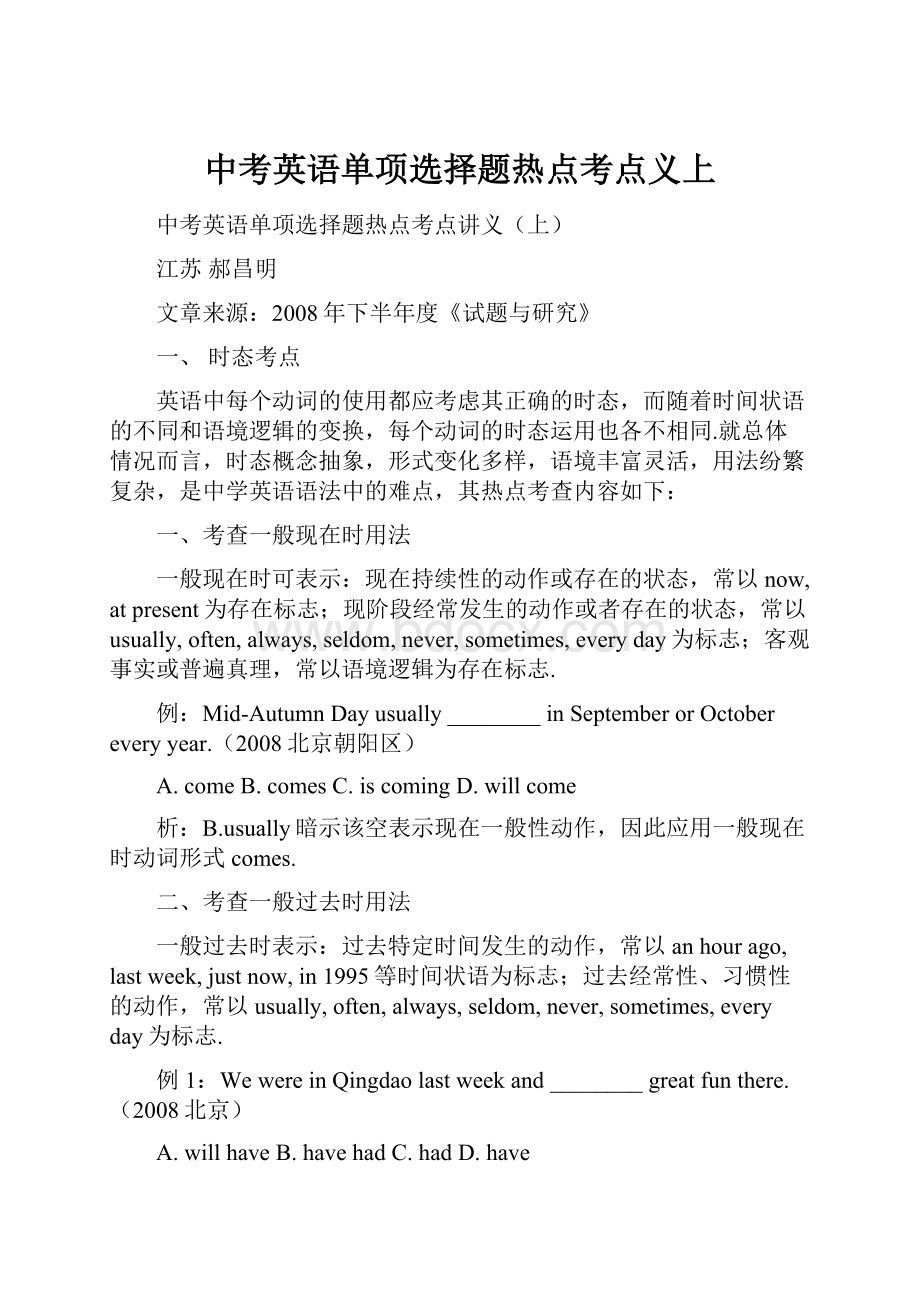中考英语单项选择题热点考点义上.docx
《中考英语单项选择题热点考点义上.docx》由会员分享,可在线阅读,更多相关《中考英语单项选择题热点考点义上.docx(32页珍藏版)》请在冰豆网上搜索。

中考英语单项选择题热点考点义上
中考英语单项选择题热点考点讲义(上)
江苏郝昌明
文章来源:
2008年下半年度《试题与研究》
一、时态考点
英语中每个动词的使用都应考虑其正确的时态,而随着时间状语的不同和语境逻辑的变换,每个动词的时态运用也各不相同.就总体情况而言,时态概念抽象,形式变化多样,语境丰富灵活,用法纷繁复杂,是中学英语语法中的难点,其热点考查内容如下:
一、考查一般现在时用法
一般现在时可表示:
现在持续性的动作或存在的状态,常以now,atpresent为存在标志;现阶段经常发生的动作或者存在的状态,常以usually,often,always,seldom,never,sometimes,everyday为标志;客观事实或普遍真理,常以语境逻辑为存在标志.
例:
Mid-AutumnDayusually________inSeptemberorOctobereveryyear.(2008北京朝阳区)
A.comeB.comesC.iscomingD.willcome
析:
B.usually暗示该空表示现在一般性动作,因此应用一般现在时动词形式comes.
二、考查一般过去时用法
一般过去时表示:
过去特定时间发生的动作,常以anhourago,lastweek,justnow,in1995等时间状语为标志;过去经常性、习惯性的动作,常以usually,often,always,seldom,never,sometimes,everyday为标志.
例1:
WewereinQingdaolastweekand________greatfunthere.(2008北京)
A.willhaveB.havehadC.hadD.have
析:
C.lastweek暗示该空应用一般过去时,因此应填had.
例2:
It’sfouryearssinceMike________toTibet.(2008石家庄)
A.hasbeenB.iscomingC.willcomeD.came
析:
D.分析语境逻辑不难发现,since从句应用一般过去时,因此该空应填came.
例3:
—Didyouwashyourclothes?
—No,IwasgoingtowashmyclothesbutI________visitors.(2008苏州)
A.havehadB.haveC.hadD.willhave
析:
C.由答句可知,主人公正准备洗衣服,忽然来了客人,因此该空应用一般过去时,应填had.
三、考查现在进行时用法
现在进行时常表示:
现在正在进行的动作,常以now或Look,Listen等动词为标志;目前这段时间正在进行但现在不一定正在进行的动作,常以语境逻辑为标志;反复性、一贯性动作,常与always连用,带有赞扬或批评的情感色彩.
例1:
—WhatisMumdoingnow?
—She________someclothes.(2008北京朝阳区)
A.washesB.iswashingC.washedD.haswashed
析:
B.now暗示该空表示“正在洗”,因此应填iswashing.
例2:
—Cindy,dinnerisready.Where’sJohn?
—He________homeworkinhisroom.(2008温州)
A.doesB.didC.isdoingD.willdo
析:
C.Where’sJohn?
暗示该空表示“现在正在做”,因此应填isdoing.
例3:
—Whosewatchislost?
—Mr.Smith’s.Look!
He________iteverywhere.(2008芜湖)
A.lookedforB.waslookingforC.looksforD.islookingfor
析:
D.Look!
暗示该空表示“现在正在寻找”,因此应填islookingfor.
四、考查过去进行时用法
过去进行时表示过去某一时刻正在进行的动作,常以then,atthetime,atthattime,atthistime,yesterday,justnow等过去特定时间点为标志,也可以以when,while等连词引导的时间状语从句为标志,还可以以上下文语境逻辑为标志.
例1:
Thechildren________aP.E.classontheplaygroundwhenitsuddenlybegantorain.(2008河北)
A.haveB.arehavingC.hadD.werehaving
析:
D.whenitsuddenlybegantorain暗示该空表示“正在下雨”,因此应用过去进行时动词形式werehaving.
例2:
—Whatdidtheteachersayjustnow?
—Sorry.Ididn’tcatchit.I________somethingelse.(2008河南)
A.thinkB.willthinkC.wasthinkingD.hadthought
析:
C.justnow暗示该空表示“正在想”,因此应用过去进行时动词形式wasthinking.
例3:
I________e-mailstomypenpalwhenSusancalledmelastnight.(2008山西)
A.wassendingB.amsendingC.sent.
析:
A.whenSusancalledmelastnight暗示该空表示“正在发送”,因此应填过去进行时动词形式wassending.
例4:
—Icalledyouat5:
00yesterdayafternoon.Buttherewasnoanswer.Wherewereyou?
—I________inthesupermarket.(2008襄樊)
A.wasshoppingB.amshoppingC.haveshoppedD.doshopping
析:
A.at5:
00yesterdayafternoon暗示该空表示“正在购物”,因此应用过去进行时动词形式wasshopping.
例5:
—Didyounoticeyourmothergooutamomentago?
—No,Ididn’t.I________TVthen.(2008厦门)
A.havewatchedB.amwatchingC.waswatching
析:
C.then暗示该空表示“正在看”,因此应用过去进行时动词形式waswatching.
五、考查现在完成时用法
现在完成时表示:
1.发生在过去某一时刻的动作对现在造成影响,常有下列标志:
yet,just,already,never,ever等副词;动作发生的次数;Itisthe+序数词+time句型;inthepast/last+时间段;recently,lately等时间性副词;语境逻辑.
2.发生在过去某一时刻的动作一直延续到现在,并且有可能继续延续下去,常以for+时间段或since+时间点为存在标志.
例1:
—Hello!
CanIspeaktoAlice?
—Sorry.Sheisn’thererightnow.She________totheshop.(2008北京)
A.goesB.willgoC.hasgoneD.wasgoing
析:
C.由语境逻辑可以推出她已经去了商店,因此该空应用现在完成时动词形式hasgone.
例2:
—WhatareyougoingtodothisSaturday?
—I________yet.(2008烟台)
A.haven’tdecidedB.won’tdecideC.amnotdecidedD.didn’tdecide
析:
A.yet暗示该空表示“到现在为止还没有决定”,因此应用现在完成时动词形式haven’tdecided.
例3:
How’sAnnie?
I________herforalongtime.(2008河北)
A.don’tseeB.won’tseeC.didn’tseeD.haven’tseen
析:
D.foralongtime为现在完成时标志.
例4:
John,ourforeignteacher,leftNantongtwoyearsago,andI________himsincethen.(2008南通)
A.don’tseeB.won’tseeC.didn’tseeD.haven’tseen
析:
D.sincethen为现在完成时标志.
例5:
ItissaidthatChery(奇瑞)________anewkindofcarrecently.(2008芜湖)
A.hasdevelopedB.developedC.developsD.haddeveloped
析:
A.recently为现在完成时标志.
例6:
—China’s24thscienceresearchteam________atChangchengStationonJanuary5,2008.
—Wonderful!
Ourscientists________alotinthisfieldalready.(2008哈尔滨)
A.havearrived;improveB.arrived;hasimprovedC.arrived;haveimproved
析:
C.onJanuary5,2008暗示第一空应填一般过去时动词形式arrived;already暗示第二空应用现在完成时动词形式haveimproved.
例7:
—________youever________Chinesemooncakes,Diana?
—No,never.ButIhavehadnoodles.(2008福州)
A.Do;tryB.Will;tryC.Did;tryD.Have;tried
析:
D.ever为现在完成时标志.
友情提醒:
for+时间段和since+时间点均需和持续性动词搭配.
例8:
He________ourschoolfortwoweeks.(2008青海)
A.leftB.hasleftC.hasbeenawayfrom
析:
C.fortwoweeks为时间段,因此该空应用持续性动词的现在完成时形式.
六、考查一般将来时用法
一般将来时有下列表达方式:
begoingtodo表示:
根据计划将要做某事;由目前情况判断有可能但是不一定会发生某事;will/shalldo表示:
根据计划将要做某事;某事一定会发生;betodo表示:
根据计划将要做某事;征求对方意见;必要性;可能性.
例1:
—Hashereturnedthelibrarybookyet?
—Notyet.Don’tworry.He________itsoon.(2008襄樊)
A.returnedB.hasreturnedC.willreturnD.returns
析:
C.soon暗示该空表示“将要还”,因此应填一般将来时动词形式willreturn.
例2:
Lookatthoseclouds.It________soon,I’mafraid.(2008莆田)
A.rainsB.wasrainingC.isgoingtorain
析:
C.soon暗示该空表示“有可能下雨”,因此应用一般将来时动词形式isgoingtorain.
友情提醒:
1.条件状语从句、时间状语从句中应用一般现在时代替一般将来时.
例1:
He’llsendusamessageassoonashe________inSichuan.(2008北京)
A.isarrivingB.willarriveC.arrivedD.arrives
析:
D.句中assoonas引导时间状语从句,应用一般现在时代替一般将来时.
例2:
Idon’tknowifmyuncle________.Ifhe________,Iwillbeveryhappy.(2008湖北恩施州)
A.comes;willcomeB.willcome;willcomeC.comes;comesD.willcome;comes
析:
D.两空均表将来动作,第一空因if引导宾语从句,可用一般将来时;第二空因If引导条件状语从句,必须用一般现在时代替一般将来时.
2.祈使句用一般现在时的形式表达一般将来时,回答时应用一般将来时.
例1:
—Don’tforgettogivemybestwishestoyourmother.
—________.(2008烟台)
A.No,Iwon’tB.OK,IwillC.Yes,Iwon’tD.Yes,Ido
析:
A.该空强调主人公将不会忘了,因此应填No,Iwon’t.C所示内容肯定与否定前后不一致,因此为错误选项.
例2:
—Pleasebringyourhomeworktoschooltomorrow,Steven.
—OK,I________.(2008河北)
A.willB.won’tC.doD.don’t
析:
A.OK暗示该空表示“明天将把家庭作业带到学校”,因此应用一般将来时.
跟踪练习:
1.—Mary,whydidn’tyoucometoattendmybirthdayparty?
—I’mverysorry.We________animportantmeeting.
A.areholdingB.wereholdingC.heldD.hadheld
2.—Listen,thereisagreatnoiseoverthere.
—Oh,twofootballteams________animportantmatch.
A.arehavingB.werehavingC.hadD.hadhad
3.—Don’tforgettobringyourlittlesisterherewhenyoucometomorrow.Iwanttobuyaskirtforher.
—I________.
A.don’tB.didn’tC.haven’tD.won’t
4.Ireallydon’tknowifhe________,butifhe________,I’lltrytoletyouknow.
A.willcome,comesB.comes,willcome
C.willcome,willcomeD.comes,comes
5.Youdon’thavetointroducehertome;I________herafewtimes.
A.metB.meetC.havemetD.hadmet
6.Idon’tknowhowlongitwillbebeforehe________toseeus.
A.willcomeB.comesC.hascomeD.hadcome
7.—Isawhersmokingataboutfiveo’clockyesterdayafternoon.
—Bushe________little.
A.smokesB.hadsmokedC.smokedD.issmoking
8.—Haveyoureadthiswonderfulmagazine?
—Yes,I________itonlylastweek.
A.readB.havereadC.hadreadD.wasreading
9.—Canyouintroducesomethingaboutthismovietome?
—Why________it?
IsawitlastWednesday.
A.didn’tyouseeB.don’tyouseeC.haven’tyouseenD.hadn’tyouseen
10.—Ipassedthedrivingtestthedaybeforeyesterday.
—Didyou.I________ityet.
A.hadn’tpassedB.haven’tpassedC.don’tpassD.didn’tpass
11.I________inBeijingforsometime,thenIwenttoShanghaiforanimportantmeeting.
A.stayB.stayedC.havestayedD.hadstayed
12.Let’shurryup.I’mafraidthatthey________forusimpatiently.
A.waitB.arewaitingC.waitedD.havewaited
13.—IstillsawlightinyourroomwhenIpassedbyyourhomeatmidnight.
—Oh,I________animportantbook.
A.readB.amreadingC.wasreadingD.haveread
14.Don’tmakeanoisehere,boysandgirls;mybaby________inside.
A.sleepsB.issleepingC.hassleptD.hadslept
15.—Iphonedyoulastnight,butIdon’tknowwhyyoudidn’tanswerme.
—Oh,I________TV.
A.watchedB.amwatchingC.waswatchingD.hadwatched
参考答案:
1~5BADAC6~10BAACB11~15BBCBC
二、被动语态考点
被动语态描绘各种情况下的被动动作,其热点考查内容如下:
一、考查一般现在时被动语态用法
一般现在时被动语态常描绘现在经常性、习惯性被动动作,动词形式为:
is/am/are+过去分词,主语为第三人称单数名词或代词时使用is,主语为I时使用am,主语为复数名词或代词时使用are.now,everyday,always,usually,often,seldom,never等词常为一般现在时被动语态成立的时间标志.
例1:
Theletter________inFrench.Ican’treadit.(2008石家庄)
A.iswritingB.iswrittenC.wroteD.writes
析:
B.该空表示“被写”,因此应用一般现在时被动语态动词形式iswritten.
例2:
Maria________at6:
30everymorningbyhermothertogetreadyforschool.(2008湖北恩施州)
A.waswokenupB.wokeupC.wakesupD.iswokenup
析:
D.everymorning暗示该空描绘现在习惯性被动动作,因此应用一般现在时被动语态动词形式iswokenup.
例3:
—Doyouplanttreesinspring?
—Yes.Manytrees________inourcityeveryyear.(2008长沙)
A.areplantingB.areplantedC.wereplanted
析:
B.everyyear暗示该空描绘现在阶段习惯性被动动作,因此应用一般现在时被动语态动词形式areplanted.
二、考查一般过去时被动语态用法
一般过去时被动语态常描绘过去特定时间发生的被动动作,动词形式为:
was/were+过去分词,主语为第三人称单数名词或代词时使用was,主语为复数名词或代词时使用were.纯粹过去时间状语和语境逻辑多为一般过去时被动语态成立的时间标志.
例1:
—Who’sthelittlebabyinthephoto,Susan?
—It’sme.Thisphoto________tenyearsago.(2008北京)
A.takesB.istakenC.tookD.wastaken
析:
D.该空表示“被拍”且有tenyearsago为时间标志,因此应用一般过去时被动语态动词形式wastaken.
例2:
Lastyear,LiHua,acollegestudent,________toworkfortheOlympicGames.(2008河北)
A.ischoosingB.ischosenC.waschoosingD.waschosen
析:
D.该空表示“被选”,且有Lastyear为时间标志,因此应用一般过去时被动语态动词形式waschosen.
例3:
—Howcleanthewindowis!
—Yes.It________justnow.(2008盐城)
A.hasbeencleanedB.wascleanedC.iscleanedD.willbecleaned
析:
B.该空表示“被打扫”,且有justnow为时间